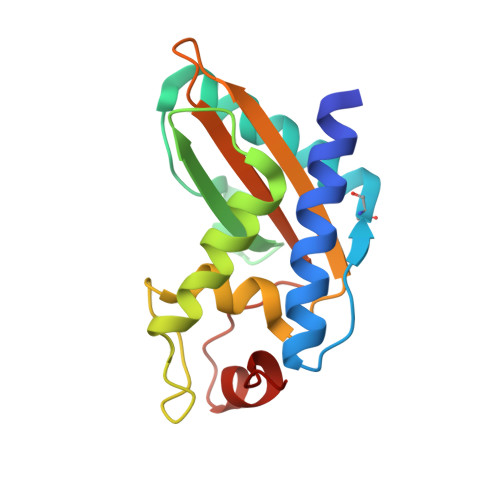Interaction of Gapr-1 with Lipid Bilayers is Regulated by Alternative Homodimerization.
Van Galen, J., Olrichs, N.K., Schouten, A., Serrano, R.L., Nolte-'T Hoen, E.N.M., Eerland, R., Kaloyanova, D., Gros, P., Helms, J.B.(2012) Biochim Biophys Acta 1818: 2175
- PubMed: 22560898
- DOI: https://doi.org/10.1016/j.bbamem.2012.04.016
- Primary Citation of Related Structures:
4AIW - PubMed Abstract:
Golgi-Associated Plant Pathogenesis-Related protein 1 (GAPR-1) is a mammalian protein that belongs to the superfamily of plant pathogenesis related proteins group 1 (PR-1). GAPR-1 is a peripheral membrane-binding protein that strongly associates with lipid-enriched microdomains at the cytosolic leaflet of Golgi membranes. Little is known about the mechanism of GAPR-1 interaction with membranes. We previously suggested that dimerization plays a role in the function of GAPR-1 and here we report that phytic acid (inositol hexakisphosphate) induces dimerization of GAPR-1 in solution. Elucidation of the crystal structure of GAPR-1 in the presence of phytic acid revealed that the GAPR-1 dimer differs from the previously published GAPR-1 dimer structure. In this structure, one of the monomeric subunits of the crystallographic dimer is rotated by 28.5°. To study the GAPR-1 dimerization properties, we investigated the interaction with liposomes in a light scattering assay and by flow cytometry. In the presence of negatively charged lipids, GAPR-1 caused a rapid and stable tethering of liposomes. [D81K]GAPR-1, a mutant predicted to stabilize the IP6-induced dimer conformation, also caused tethering of liposomes. [A68K]GAPR-1 however, a mutant predicted to stabilize the non-rotated dimer conformation, is capable of binding to liposomes but did not cause liposome tethering. Our combined data suggest that the charge properties of the lipid bilayer can regulate GAPR-1 dynamics as a potential mechanism to modulate GAPR-1 function.
- Department of Biochemistry and Cell Biology, Utrecht University, Utrecht, The Netherlands.
Organizational Affiliation:


















